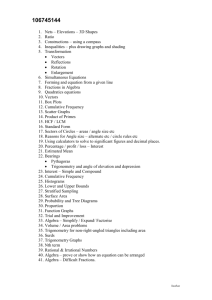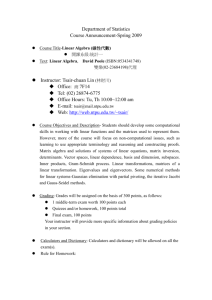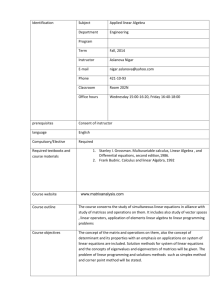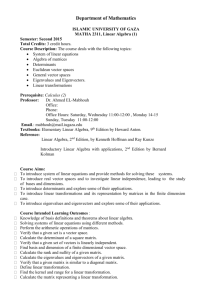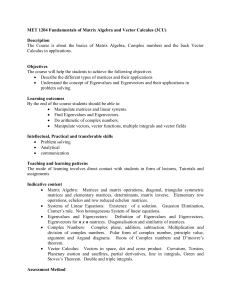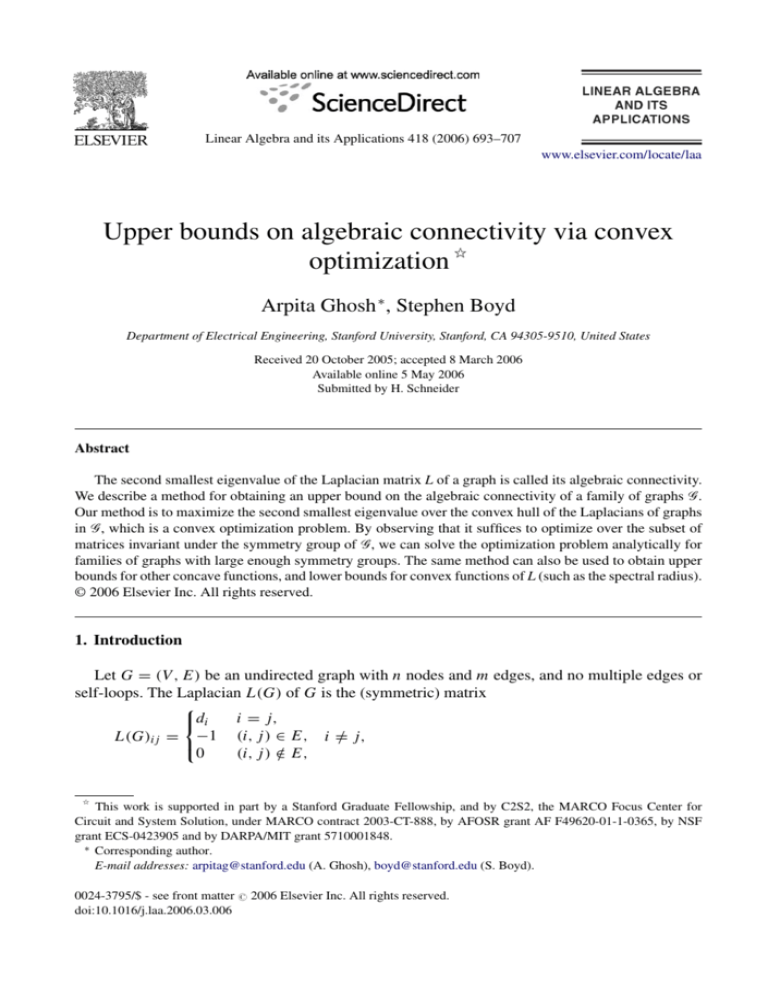
Linear Algebra and its Applications 418 (2006) 693–707
www.elsevier.com/locate/laa
Upper bounds on algebraic connectivity via convex
optimization 聻
Arpita Ghosh ∗ , Stephen Boyd
Department of Electrical Engineering, Stanford University, Stanford, CA 94305-9510, United States
Received 20 October 2005; accepted 8 March 2006
Available online 5 May 2006
Submitted by H. Schneider
Abstract
The second smallest eigenvalue of the Laplacian matrix L of a graph is called its algebraic connectivity.
We describe a method for obtaining an upper bound on the algebraic connectivity of a family of graphs G.
Our method is to maximize the second smallest eigenvalue over the convex hull of the Laplacians of graphs
in G, which is a convex optimization problem. By observing that it suffices to optimize over the subset of
matrices invariant under the symmetry group of G, we can solve the optimization problem analytically for
families of graphs with large enough symmetry groups. The same method can also be used to obtain upper
bounds for other concave functions, and lower bounds for convex functions of L (such as the spectral radius).
© 2006 Elsevier Inc. All rights reserved.
1. Introduction
Let G = (V , E) be an undirected graph with n nodes and m edges, and no multiple edges or
self-loops. The Laplacian L(G) of G is the (symmetric) matrix
i = j,
di
L(G)ij = −1 (i, j ) ∈ E, i =
/ j,
0
(i, j ) ∈
/ E,
聻
This work is supported in part by a Stanford Graduate Fellowship, and by C2S2, the MARCO Focus Center for
Circuit and System Solution, under MARCO contract 2003-CT-888, by AFOSR grant AF F49620-01-1-0365, by NSF
grant ECS-0423905 and by DARPA/MIT grant 5710001848.
∗ Corresponding author.
E-mail addresses: arpitag@stanford.edu (A. Ghosh), boyd@stanford.edu (S. Boyd).
0024-3795/$ - see front matter ( 2006 Elsevier Inc. All rights reserved.
doi:10.1016/j.laa.2006.03.006
694
A. Ghosh, S. Boyd / Linear Algebra and its Applications 418 (2006) 693–707
where di is the degree of node i. The Laplacian L(G) satisfies
L(G) = L(G)T , L(G) 0, L(G)1 = 0, L(G)ij ∈ {0, −1} for i =
/ j,
(1)
where denotes matrix inequality, and 1 is the vector of all ones. In other words, the Laplacian is
symmetric positive semidefinite, each row sums to zero, and its off-diagonal elements are either
zero or minus one. Conversely, if L is any n × n matrix that satisfies these conditions, then it is
the Laplacian of some graph on n nodes. We will denote the set of all Laplacians on n nodes as
L:
L = {L ∈ Rn×n |L = LT , L 0, L1 = 0, Lij ∈ {0, −1}
for i =
/ j }.
We denote the eigenvalues of a Laplacian L(G) as λ1 = 0 λ2 · · · λn . The second-smallest
eigenvalue of L(G), λ2 , is called the algebraic connectivity of G, and is positive if and only if
the graph is connected (see, e.g., [6]). The largest eigenvalue λn is the spectral radius.
Let G be a set of graphs on n nodes, and let L(G) = {L(G) | G ∈ G} be the associated set of
Laplacian matrices. We are interested in finding an upper bound on the algebraic connectivity of
the graphs in G. In principle, we can compute the maximum algebraic connectivity,
λ夝 = max{λ2 (L)|L ∈ L(G)},
by evaluating λ2 (L(G)) for each G ∈ G. The sets of graphs we are interested in can be extremely
large, however, so this is not practical; we seek instead a simple upper bound that depends on
some parameters in the description of G.
1.1. Previous work
The Laplacian matrix and its spectrum, particularly the algebraic connectivity and the spectral
radius, have been extensively studied. A survey of results and applications can be found in [19]
and [21,22] discusses applications of the Laplacian in various fields. The work of Fiedler [6] is one
of the earliest addressing the Laplacian matrix, and contains many fundamental results, including
upper and lower bounds on the algebraic connectivity. For example, Fiedler shows that
ndmin
2m
λ2 (L(G)) ,
(2)
n−1
n−1
where dmin is the minimum degree of the nodes of G, and that
λ2 (L(G)) v(G),
(3)
where v(G) is the vertex connectivity, i.e., the minimum number of nodes that need to be deleted
to disconnect the graph. (Our method will reproduce all three inequalities.)
Many other upper bounds on λ2 (L) have been found in terms of various properties of the graph.
In [15] and [14], the author provides tight upper bounds for the algebraic connectivity of a graph
with a given number of cut-points. (A cut-point is a vertex whose deletion disconnects the graph).
In [7], the authors minimize and maximize λ2 (L) for trees of given diameter, and minimize λ2 (L)
for general graphs of given girth (which is the length of the shortest cycle in the graph). In [8],
an upper bound is established in terms of the minimum edge density. The recent work in [16]
derives an upper bound for the algebraic connectivity in terms of the domination number of the
graph, i.e., the cardinality of the smallest set S such that every element of V (G)\S is adjacent to
a vertex of S.
The problem of obtaining lower bounds for the algebraic connectivity and upper bounds for the
spectral radius of the Laplacian in terms of various properties of the graph has also been studied;
see, for example, [12,17,18,25,20,13].
A. Ghosh, S. Boyd / Linear Algebra and its Applications 418 (2006) 693–707
695
A closely related problem, which arises in the study of Markov chains and various iterative
processes, concerns the matrices I − D −1 L and D −1/2 LD −1/2 , where D is the diagonal matrix
of node degrees, i.e., Dii = Lii . Here the objective is to find upper bounds on the spectral gap
of the stochastic matrix I − D −1 L, which is the same as λ2 (D −1/2 LD −1/2 ), in terms of various
graph properties; see, for example [3,5,13] and references therein.
2. Our method
2.1. The basic bound
Our method for finding a bound on λ夝 is simple. We observe that
λ夝 = max{λ2 (L)|L ∈ L(G)} λ̄ = sup{λ2 (L)|L ∈ Co L(G)},
where Co denotes convex hull. This inequality follows immediately from Co L(G) ⊇ L(G). We
will evaluate λ̄, exploiting the fact that it is the supremum of a concave function over a convex set.
Thus, to evaluate λ̄ requires solving a convex optimization problem, i.e., maximizing a concave
function over a convex set. Roughly speaking, such problems are easy to solve (in most cases)
using numerical methods [2]. Here, however, we will consider cases where the problem can be
solved analytically.
To see that λ2 is a concave function of L on Co L (and therefore on Co L(G) for any G), we
argue as follows. Each L ∈ Co L is positive semidefinite, and has λ1 (L) = 0, with corresponding
eigenvector 1. Thus we can express λ2 (L) as [11, §4.2]
λ2 (L) = inf{x T Lx|x2 = 1, 1T x = 0}.
For each x ∈ Rn that satisfies x2 = 1 and 1T x = 0, x T Lx is a linear (and therefore also concave)
function of L. The formula above shows that λ2 is the infimum of a family of concave functions
in L, and is therefore also a concave function of L [2, §3.2.3]. For future use, we note that Co L,
the convex hull of the set of all Laplacians on n nodes, has the form
Co L = {L ∈ Rn×n |L = LT , L 0, L1 = 0, −1 Lij 0
for i =
/ j },
(4)
i.e., it is the set of symmetric positive semidefinite matrices, with zero row sums, and off-diagonal
elements between minus one and zero.
2.2. Exploiting symmetry
The symmetry group of G can be exploited to reduce the size of the convex optimization
problem that we must solve to evaluate our bound λ̄. The idea of exploiting symmetry in convex
optimization problems has recently found strong interest; see [24,4].
Let P denote the group of permutation matrices in Rn×n . An element P ∈ P acts on a matrix
L as P LP T . If L is the Laplacian of a graph G, then P LP T is the Laplacian of the graph G
obtained by permuting the nodes of G by P . Let S be the symmetry group of L(G), i.e.,
S = {P ∈ P|P LP T ∈ L(G) for each L ∈ L(G)}.
(5)
The group of permutations S also leaves Co L(G) invariant. (In what follows, we will only use
the fact that S is a group of permutations that leaves L(G) invariant i.e., it can be a subgroup of
the symmetry group.)
696
A. Ghosh, S. Boyd / Linear Algebra and its Applications 418 (2006) 693–707
Let I denote the subspace of symmetric n × n matrices that are invariant under S, i.e.,
I = {M ∈ Rn×n |M = M T , P MP T = M
for all P ∈ S}.
(6)
We claim that
λ̄ = sup{λ2 (L)|L ∈ Co L(G) ∩ I}.
(7)
In other words, to maximize λ2 over Co L(G), we can without loss of generality restrict our
search to elements of Co L(G) that are invariant under S (see, e.g., [2, Example 4.4]).
To show this, suppose that L夝 ∈ Co L(G) satisfies λ2 (L夝 ) = λ̄, i.e., L夝 achieves the maximum value of λ2 over Co L(G). (Such an L夝 exists because λ2 is continuous and Co L(G) is
compact.) Now define
1 L=
P L夝 P T .
(8)
|S|
P ∈S
Clearly L ∈ Co L(G). Since
λ2 (P L夝 P T ) = λ2 (L夝 ) = λ̄
for any permutation matrix P , and λ2 is a concave function, Jensen’s inequality and (8) tell us
that
λ2 (L) λ2 (L夝 ) = λ̄.
(9)
It follows that L also maximizes λ2 over Co L(G). Our claim (7) is established, since L ∈ I.
3. Examples
In each of the following subsections, we carry out our method of obtaining an upper bound
on the algebraic connectivity for a specific set G of graphs. We start by identifying the symmetry
group S of G. We then identify I, the set of matrices invariant under S, and finally, we evaluate
λ̄ using (7).
3.1. Degree distribution constraints
We start with a simple example where the symmetry group is the set of all permutation matrices.
We consider graphs specified by constraints on the degree distribution, i.e.,
d[1] , d[2] , . . . , d[n] ,
which are the degrees of the nodes sorted in decreasing order. (Thus, d[r] denotes the rth largest
degree of a node in the graph.)
For any family of graphs G specified by constraints on the degree distribution, the symmetry
group of L(G) is P, since every permutation leaves the degree distribution, i.e., d[i] , unchanged.
The subspace I of symmetric matrices invariant under P consists of matrices with a constant
value along the main diagonal, and a constant value for the off-diagonal elements. Therefore,
from (4), we have
Co L ∩ I = {L|L = nαI − α11T , 0 α 1}.
(10)
We now consider a specific constraint on the degree distribution, and find λ̄2 for this family of
graphs. Let G be the set of graphs for which the sum of the r largest degrees does not exceed Dr ,
i.e.,
A. Ghosh, S. Boyd / Linear Algebra and its Applications 418 (2006) 693–707
697
d[1] + d[2] + · · · + d[r] Dr .
Clearly we can assume 0 Dr r(n − 1). We can express this constraint in terms of L as
Lii[1] + Lii[2] + · · · + Lii[r] Dr ,
(11)
where Lii[j ] is the j th largest diagonal entry of L. This constraint is convex [2, §3.2.3]. Therefore,
Co L(G) ∩ I is the subset of matrices in Co L ∩ I that satisfy (11), i.e.,
Co L(G) ∩ I = {L|nαI − α11T , 0 α 1, r(n − 1)α Dr }.
(12)
The eigenvalues of the matrix nαI − α11T are 0, and nα with multiplicity n − 1, which increase
monotonically with α. So to maximize λ2 over Co L(G) ∩ I, we set α = Dr /(n − 1)r. This
gives us the bound
λ̄ =
nDr
.
r(n − 1)
(13)
A special case of (11) is r = n, Dr = 2m. Using this in (13) gives us a bound on the algebraic
connectivity of graphs with at most m edges,
2m
,
n−1
which recovers the bound in [6].
λ̄ =
3.2. Graphs with small cuts
We consider graphs in which there exists a cut with no more than mc edges, which breaks
the graph into two sets of nodes of sizes n1 and n2 (with n1 + n2 = n). (Note that not every cut
separating the graph into sets of size n1 and n2 needs to have fewer than mc edges.) We will derive
a bound for λ2 (L(G)) in terms of n1 , n2 , and mc .
We can assume that 0 mc n1 n2 . Without loss of generality, we label the nodes in the two
sets as {1, . . . , n1 } and {n1 + 1, . . . , n}. Thus our set G consists of graphs for which there are no
more than mc edges between the set of nodes 1, . . . , n1 and the set of nodes n1 + 1, . . . , n. An
example is shown in Fig. 1.
Fig. 1. A graph with a cut (shown as the dotted line) containing three edges (shown as dashed lines). The cut separates
nodes 1, . . . , 4 from nodes 5, . . . , 9. For this graph, we have mc = 3, n1 = 4, and n2 = 5.
698
A. Ghosh, S. Boyd / Linear Algebra and its Applications 418 (2006) 693–707
In terms of the associated Laplacian matrices, this means that in the 1, 2 n1 × n2 block, there
are no more than mc entries that are −1. (The other entries in the block are, of course, zero.) Thus,
matrices in L(G) are the elements of L that satisfy
n1
n
−Lij mc .
(14)
i=1 j =n1 +1
The symmetry group of L(G) (for n1 =
/ n2 ) consists of the matrices
0
P
,
P = 1
0 P2
(15)
where P1 and P2 are permutation matrices in Rn1 ×n1 and Rn2 ×n2 respectively. When n1 = n2 ,
the symmetry group is larger, consisting of matrices in (15) as well as matrices of the form
0 P2
.
P =
P1
0
However, this larger symmetry group leads to the same bound as that obtained by setting n1 =
n2 = n/2 in (19), so we do not discuss the case n1 = n2 separately.
The set I of matrices that are invariant under S consists of matrices of the form
−b11T
αI − a11T
,
(16)
M=
−b11T
βI − c11T
where the vectors of ones are of the appropriate sizes. For a matrix of this form to belong to L,
it must have zero row sum, i.e.,
α = an1 + bn2 ,
β = bn1 + cn2 .
Since the off-diagonal entries must lie between 0 and −1, we have 0 a, b, c 1. Therefore,
from (14), we have
Co L(G) ∩ I = {M|0 a, b, c 1, α = an1 + bn2 , β = bn1 + cn2 , bn1 n2 mc },
(17)
where M has the structure in (16).
The eigenvalues of a matrix in (17) are shown in the appendix to be
• 0 (with multiplicity one),
• an1 + bn2 with multiplicity n1 − 1,
• bn1 + cn2 , with mulitplicity n2 − 1,
• b(n1 + n2 ) (with multiplicity one).
Therefore, to maximize the second smallest eigenvalue over Co L ∩ I, we must solve the
problem
maximize
subject to
min{an1 + bn2 , bn1 + cn2 , b(n1 + n2 )}
0 a 1, 0 c 1, 0 b mc /n1 n2 ,
(18)
with variables a, b, and c. The objective is non-decreasing in a, b, and c, so the choices a = 1,
c = 1, and b = mc /n1 n2 give the optimal value, which is
mc n
mc (n1 + n2 )
=
.
(19)
λ̄ =
n1 n2
n1 n2
A. Ghosh, S. Boyd / Linear Algebra and its Applications 418 (2006) 693–707
699
This recovers the bound in [8] and [23],
λ2 (L) min
X⊆V
|V ||EX |
,
|X||X c |
where EX is the number of edges between a subset of nodes X and its complement X c . The work
in [8] addresses the problem of which graphs satisfy this bound with equality.
We also note that Fiedler’s bound (2) follows from (19). To see this, choose any node of
minimum degree, and consider the cut consisting of its adjacent edges. This cut has size mc = dmin ,
and disconnects the graph into two sets of nodes, with sizes n1 = 1 and n2 = n − 1. The bound
(19) then reduces to Fiedler’s bound (2).
3.3. Graphs with non-adjacent subsets
Our next example concerns graphs with no more than m edges, with q non-adjacent, disjoint
subsets S1 , . . . , Sq , each containing p nodes. (Si and Sj are non-adjacent if there are no edges
between them.) We denote the remaining t = n − pq nodes as T :
T = {1, . . . , n}\(S1 ∪ · · · ∪ Sq ).
We will derive a bound on λ2 (L(G)) in terms of m, p, q and t.
Without loss of generality, we can assume that
S1 = {1, . . . , p}, S2 = {p + 1, . . . , 2p}, . . . , Sq = {(q − 1)p + 1, . . . , pq},
T = {pq + 1, . . . , n}.
We let G consist of graphs with this form, with no more than m edges. An example is shown in
Fig. 2.
Fig. 2. A graph with n = 16 nodes, m = 17 edges, and q = 3 non-adjacent subsets, S1 , S2 , and S3 , each containing
p = 4 nodes. The set T consists of the remaining nodes: 13, 14, 15 and 16.
700
A. Ghosh, S. Boyd / Linear Algebra and its Applications 418 (2006) 693–707
For this G, matrices in L(G) have the block arrow form
L1
R1
..
..
.
.
L=
,
Lq
Rq
R1T · · · RqT Lq+1
(20)
where Li ∈ Rp×p , i = 1, . . . , q, Lq+1 ∈ Rt×t , and Ri ∈ Rp×t , and
i =j
/
−Lij =
n
Lii 2m.
i=1
(Blocks not shown are zero.)
The set L(G) is invariant under a permutation of nodes within each subset S1 , . . . , Sq and T ,
as well as permutations of the q subsets S1 , . . . , Sq amongst themselves. That is, the symmetry
group of L(G) consists of the matrices
P̃
P =
,
Pt
where Pt is a permutation matrix in Rt×t , and
1
Pp
..
P̃ = (Pq ⊗ Ip )
,
.
(21)
Ppk
where Pq and Ppi are permutation matrices in Rq×q and Rp×p respectively, and Ip is the identity
matrix in Rp×p . (The symbol ⊗ denotes Kronecker product.)
A matrix that is invariant under any permutation in S is of the form
α̃I − ã11T
−b̃11T
M=
,
(22)
β̃I − c̃11T
−b̃11T
where the vectors of ones are of the appropriate sizes.
From (20) and (22), we see that matrices in Co L(G) ∩ I are of the form
αI − a11T
−b11T
..
..
.
.
M=
,
αI − a11T
−b11T
−b11T
···
−b11T
βI − c11T
where
α = ap + bt,
β = pqb + ct,
0 a, b, c 1,
qp(p − 1)a + t (t − 1)c + 2pqtb 2m.
The eigenvalues of M are shown in the appendix to be
• 0, with multiplicity 1,
• ap + bt, with multiplicity q(p − 1),
• pqb + tc, with multiplicity t − 1,
• bt, with multiplicity q − 1,
• b(t + qp) with multiplicity 1.
(23)
A. Ghosh, S. Boyd / Linear Algebra and its Applications 418 (2006) 693–707
701
Since a and c are non-negative, the second smallest eigenvalue of M is
λ2 = min{tb, pqb + tc}.
To find the bound λ̄, we must solve the problem
maximize
subject to
min{tb, pqb + tc}
0 a, b, c 1, qp(p − 1)a + t (t − 1)c + 2pqtb 2m,
(24)
with variables a, b, and c. This is small linear program that we can solve analytically. We start
by noting that the objective does not depend on a, and is non-decreasing in b and c. The second
inequality is increasing in a, b, and c, so it follows that we should take a = 0. To find the optimal
values for the two remaining variables b and c, we consider two cases: pq t, and pq < t.
Suppose that pq t. Then the objective in (24) is bt, so the problem reduces to maximizing b.
The optimal value of c is zero, which allows b to be as large as possible, i.e., b = min{m/pqt, 1}.
This yields the optimal value
λ̄ = min{t, m/(pq)}.
Now consider the case when pq < t. In this case the two terms in the objective are equal at the
optimal point, i.e., tb = pqb + tc. Using this in the constraint
t (t − 1)c + 2pqtb 2m,
we get
2m
.
b = min 1,
(t − 1)(t − pq) + 2pqt
This gives us
2mt
λ̄ = min t,
.
(t − 1)(t − pq) + 2pqt
In summary, we have the following:
2mt
,
(25)
λ̄ = min t,
(t − 1)(t − pq)+ + 2pqt
where (t − pq)+ denotes the positive part of t − pq, i.e., max{t − pq, 0}. This is our final bound
for graphs with q non-adjacent subsets, each with p nodes, and no more than m edges.
We can connect our bound to the simple one (3) based on vertex connectivity. The vertex
connectivity of any graph in G is less than or equal to t, since deleting the nodes in T will surely
disconnect the graph. Thus the simple bound gives us λ2 (L(G)) v(G) t. If in our bound we
ignore the constraint on the total number of edges (or just set the number of edges to its largest
possible value, m = n(n − 1)/2), we also obtain
λ2 (L(G)) λ̄ = t.
3.4. Graphs with ring structure
We consider graphs with no more than m edges, with the following block ring structure. The
nodes can be divided into q > 1 disjoint sets of nodes, S1 , . . . , Sq , each with p nodes (n = pq),
such that there are edges between sets Si and Sj only if |i − j | 1 or |i − j | = q − 1. In other
words, S1 can be adjacent only to Sq and S2 , S2 can be adjacent only to S1 and S3 , and so on; Sq
can be adjacent only to Sq−1 and S1 . We will derive a bound on λ2 (L(G)) in terms of m, p and q.
702
A. Ghosh, S. Boyd / Linear Algebra and its Applications 418 (2006) 693–707
Fig. 3. A graph with n = 16 nodes, m = 19 edges, and a ring structure with q = 4 subsets, S1 , . . . , S4 , each containing
p = 4 nodes.
Without loss of generality, we can assume that
S1 = {1, . . . , p}, . . . , Sq = {(q − 1)p + 1, . . . , n}.
Our set G will be graphs with this structure, with no more than m edges in total. An example is
shown in Fig. 3.
Note that if q < 4, then this requirement does not impose any structure on the graph, since all
of the q subsets are adjacent to each other. Therefore, we will assume for the remainder of this
section that q 4.
For this G, L(G) is the subset of matrices in (1) that have the form
R11 R12
R1q
T
R12 R22
R23
L=
(26)
,
..
.
T
R1q
Rqq−1 Rqq
where Rij ∈ Rp×p , and
n
Lii 2m.
i=1
(The sparsity structure of L could be called block tridiagonal circulant.)
The set L(G) is invariant under a permutation of nodes within each of the sets S1 , . . . , Sq ,
as well as to cyclic rotations of the sets, and reversal of the ordering of the subsets. That is, the
symmetry group of L(G) consists of the permutation matrices
1
P
..
P = (P̃ ⊗ Ip )
,
.
Pq
where P i ∈ Rp×p are permutation matrices, and P̃ ∈ Rq×q is a cyclic permutation or reversal.
That is, P is a block cyclic permutation matrix, with every block a permutation matrix in R p×p .
A. Ghosh, S. Boyd / Linear Algebra and its Applications 418 (2006) 693–707
703
The set of symmetric matrices invariant under S has elements of the form αIn − C ⊗ 11T ,
where C ∈ Rq×q is a symmetric circulant matrix. Therefore, the set of matrices in Co L(G) ∩ I
has the form
M = αIn − C ⊗ 11T ,
(27)
where C is the circulant matrix
a b
b
b a
b
C=
,
..
.
b
b
(28)
a
and
α = p(a + 2b);
n(p − 1)a + 2npb 2m.
The eigenvalues of C are (see, for example, [10])
µj = a + 2b cos(2πj/q),
j = 1, . . . , q.
⊗ 11T /n are 0
So the eigenvalues of C
the eigenvalues of M are
repeated n − q times, and pµj , j = 1, . . . , q. Therefore,
• ap + 2bp, with multiplicity n − q, and
• 2bp(1 − cos(2πj/q)), with multiplicity 1, for j = 1, . . . , q.
For j = q, 1 − cos(2πj/q) = 0. The second smallest value of 2pb(1 − cos(2πj/q)) is obtained for j = 1 (or j = q − 1). Therefore,
λ2 = min(ap + 2bp, 2bp(1 − cos(2π/q)).
For q 4, cos(2π/q) 0, and therefore λ2 = 2bp(1 − cos(2π/q)), which does not depend on
a, and is increasing in b. Therefore, to maximize λ2 over Co L(G) ∩ I, we set a = 0, and
b = m/np. This gives us the following upper bound on the algebraic connectivity of graphs with
n nodes, no more than m edges, and a block ring structure with q 4 blocks:
2m
λ̄ =
(1 − cos(2π/q)).
(29)
n
When 1 < q < 4, the same method still works; in this case, we obtain an upper bound on the
algebraic connectivity over the set of all graphs with no more than m edges. The bound we obtain
here is, once again,
2m
λ̄ =
.
n−1
4. Bounds for other functions
Our method relies only on the fact that λ2 (L) is a concave function of L on Co L, which is
invariant under any permutation of the nodes. The same method can also be used to obtain an
upper bound on any other concave function, or a lower bound on any convex function, which is
invariant under node permutation. As above, we can restrict the optimization to the subspace of
symmetric matrices invariant under the symmetry group. As examples, the same method can be
used to find the following bounds.
704
A. Ghosh, S. Boyd / Linear Algebra and its Applications 418 (2006) 693–707
• Spectral radius. The largest eigenvalue λn (L) is convex function of L, so by minimizing it
over L ∈ Co L(G) (which is a convex optimization problem), we obtain a lower bound on
λn (L) over G.
• Sum of k largest or k smallest eigenvalues. The sum of the k largest eigenvalues of L,
f (L) =
k−1
λn−i (L)
i=0
is a convex function of L. Similarly, the sum of the smallest k eigenvalues,
g(L) =
k
λi (L),
i=2
is a concave function of L. Therefore, our method can be used to find a lower bound on f (L)
and an upper bound on g(L) over a family of graphs G. (For k = 1, these functions reduce to
the spectral radius and the algebraic connectivity respectively.)
• Geometric mean of eigenvalues. The function
n 1/(n−1)
λi
i=2
is concave, so we can find an upper bound on it. The same upper bound can also be found by
maximizing the concave function
log det(L + 11T /n) =
n
log λi (L).
i=2
The product of the largest n − 1 eigenvalues of the Laplacian is related to the number of
spanning trees in G by the matrix-tree theorem (see, for example, [21]): the number of spanning
trees in G, κ(G), is given by
1
λi (L(G)).
n
n
κ(G) =
i=2
Thus we can find an upper bound on the number of spanning trees in graphs belonging to some
family of graphs G.
• Total effective resistance. The total effective resistance of a graph is proportional to
n
T
−1
λ−1
−1
i = Tr(L + 11 /n)
i=2
(see [9]). This is a convex function of L, so we can find a lower bound on the total resistance,
over a family of graphs, using the method outlined above.
• Mean-square-variance in distributed averaging. When a graph is used as a distributed averaging network, with random noises acting on each edge, the total variance of the error is
proportional to
n
T
−2
λ−2
−1
i = Tr(L + 11 /n)
i=2
(see [26]). This is a convex function of L, so our method can be used to find a lower bound on
it.
A. Ghosh, S. Boyd / Linear Algebra and its Applications 418 (2006) 693–707
705
Each of these functions of L is a spectral function, i.e., a symmetric function of the eigenvalues
of a symmetric matrix. A spectral function g(λ(L)) is closed and convex if and only if g is closed
and convex; this can be used to show convexity of the functions above. For more on spectral
functions, see [1].
Appendix
We want to find the eigenvalues of the matrix
αI − a11T
−b11T
L=
,
βI − c11T
−b11T
(30)
where α and β satisfy
α = an1 + bn2 ,
β = bn1 + cn2 .
We can diagonalize αI − a11T as
T
1
1
αI − a11T = √n1 1 U D1 √n1 1
(31)
U ,
(32)
where D1 ∈ Rn1 ×n1 is the diagonal matrix with entries α − an1 , α, . . ., α, and U ∈ Rn1 ×n1 −1 is
an orthonormal basis for 1⊥ . We can similarly diagonalize βI − c11T as
T
1
1
(33)
βI − c11T = √n2 1 V D2 √n2 1 V ,
where D2 has entries β − cn2 , β, . . . , β, and V ∈ Rn2 ×n2 −1 is an orthonormal basis for 1⊥ .
We have
T 1
√ 1 U
0
b11T
αI − a11T
n1
√1 1 V
b11T
βI − c11T
0
n2
1
√ 1 U
0
D1 S T
n1
=
×
,
(34)
√1 1 V
S
D2
0
n
2
√
where S ∈
has S11 = −b n1 n2 , and all other entries zero.
The right-hand side matrix can be permuted to
√
α − an1
−b n1 n2
√
−b n1 n2
β − cn2
αIn1 −1
βIn2 −1
√
bn2
−b n1 n2
√
−b n1 n2
bn1
,
=
αIn1 −1
βIn2 −1
Rn2 ×n1
(35)
which has eigenvalues α repeated n1 − 1 times, β repeated n2 − 1 times, 0, and b(n1 + n2 ). Since
this block-diagonal matrix is obtained from L by a series of similarity transformations, these are
also the eigenvalues of L.
706
A. Ghosh, S. Boyd / Linear Algebra and its Applications 418 (2006) 693–707
Next we find the eigenvalues of
αI − a11T
..
.
L夝 =
αI − a11T
T
···
−b11T
−b11
−b11T
..
.
.
−b11T
βI − c11T
By a similarity transform like the one above, this matrix can be transformed to the matrix
D1
ST
..
..
.
.
,
D1 S T
S
···
S
D2
(36)
(37)
where D1 is diagonal with entries α − an1 , α, . . ., α, D2 is diagonal with entries β − cn2 , β, . . .,
√
β, and S ∈ Rn2 ×n1 has S11 = −b n1 n2 , and all other entries zero.
This matrix can be permuted to a block diagonal matrix
√
α − an1
−b n1 n2
..
..
.
.
√
α − an1
−b n1 n2
√
−b n1 n2 . . . −b√n1 n2
β − cn2
αIk(n1 −1)
βIn2 −1
√
bn2
−b n1 n2
..
..
.
.
√
bn2
−b n1 n2
= √
.
√
−b n1 n2 . . . −b n1 n2
kbn1
αIk(n1 −1)
βIn2 −1
The eigenvalues of the top left block can be computed to be 0, bn2 repeated k − 1 times, and
b(n2 + kn1 ). So the eigenvalues of L夝 (which are the same as those of the above block diagonal
matrix) are 0, bn2 repeated k − 1 times, b(n2 + kn1 ), α repeated k(n1 − 1) times, and β repeated
n2 − 1 times.
Acknowledgments
We are indebted to Persi Diaconis for much valuable advice.
References
[1] J. Borwein, A. Lewis, Convex Analysis and Nonlinear Optimization, Theory and Examples, Canadian Mathematical
Society Books in Mathematics, Springer-Verlag, New York, 2000.
[2] S. Boyd, L. Vandenberghe, Convex Optimization, Cambridge University Press, 2004, Available from: <www.stanford.edu/∼boyd/cvxbook>.
[3] F. Chung, Spectral Graph Theory, AMS, 1997.
A. Ghosh, S. Boyd / Linear Algebra and its Applications 418 (2006) 693–707
707
[4] E. de Klerk, D. Pasechnik, A. Schrijver, Reduction of symmetric semidefinite programs using the regular ∗ -representation, Optimization Online, 2005.
[5] P. Diaconis, D. Stroock, Geometric bounds for eigenvalues of Markov chains, Ann. Appl. Probab. 1 (1) (1991)
36–61.
[6] M. Fiedler, Algebraic connectivity of graphs, Czech. Math. J. 23 (1973) 298–305.
[7] S. Fallat, S. Kirkland, Extremizing algebraic connectivity subject to graph theoretic constraints, Electron. J. Linear
Algebra 3 (1998) 48–74.
[8] S. Fallat, S. Kirkland, S. Pati, On graphs with algebraic connectivity equal to minimum edge density, Linear Algebra
Appl. 373 (2003) 31–50.
[9] A. Ghosh, S. Boyd, A. Saberi, Optimizing effective resistance of a graph, 2005. Available from: <www.stanford.edu/∼boyd/eff_res>.
[10] R. Gray, Toeplitz and circulant matrices: a review, 1971. Available from: <www-ee.stanford.edu/∼gray/toeplitz>.
[11] R. Horn, C. Johnson, Matrix Analysis, Cambridge University Press, Cambridge, UK, 1985.
[12] W. Anderson Jr., T. Morley, Eigenvalues of the Laplacian of a graph, Linear and Multilinear Algebra 18 (1985)
141–145.
[13] N. Kahale, A semidefinite bound for mixing rates of Markov chains, Random Struct. Algorithms 11 (4) (1997)
299–313.
[14] S. Kirkland, A bound on the algebraic connectivity of a graph in terms of the number of cutpoints, Linear and
Multilinear Algebra 47 (2000) 93–103.
[15] S. Kirkland, An upper bound on algebraic connectivity of graphs with many cutpoints, Electron. J. Linear Algebra
8 (2001) 94–109.
[16] M. Lu, H. Liu, F. Tian, Bounds of Laplacian spectrum of graphs based on the domination number, Linear Algebra
Appl. 402 (2005) 390–396.
[17] J. Li, X. Zhang, A new upper bound for eigenvalues of the Laplacian matrix of a graph, Linear Algebra Appl. 265
(1997) 93–100.
[18] J. Li, X. Zhang, On Laplacian eigenvalues of a graph, Linear Algebra Appl. 285 (1998) 305–307.
[19] R. Merris, Laplacian matrices of graphs: a survey, Linear and Multilinear Algebra 197/198 (1994) 143–176.
[20] R. Merris, A note on Laplacian graph eigenvalues, Linear Algebra Appl. 285 (1998) 33–35.
[21] B. Mohar, The Laplacian spectrum of graphs, Graph Theory Combin. Appl. 2 (1991) 871–898.
[22] B. Mohar, Some applications of the Laplace eigenvalues of graphs, graph symmetry: algebraic methods and applications, NATO ASI Ser. C 497 (1997) 225–275.
[23] B. Mohar, S. Poljak, Eigenvalue methods in combinatorial optimization, Combinat. Graph-Theor. Prob. Linear
Algebra 50 (1993) 107–151.
[24] P. Parrilo, Structured semidefinite programs and semialgebraic geometry methods in robustness and optimization,
Ph.D. thesis, California Institute of Technology, Pasadena, CA, May 2000.
[25] O. Rojo, R. Soto, H. Rojo, An always nontrivial upper bound for Laplacian graph eigenvalues, Linear Algebra Appl.
312 (2000) 155–159.
[26] L. Xiao, S. Boyd, S.-J. Kim, Distributed average consensus with least-mean-square deviation, 2005. Available from:
<www.stanford.edu/∼boyd/lms_consensus>.




